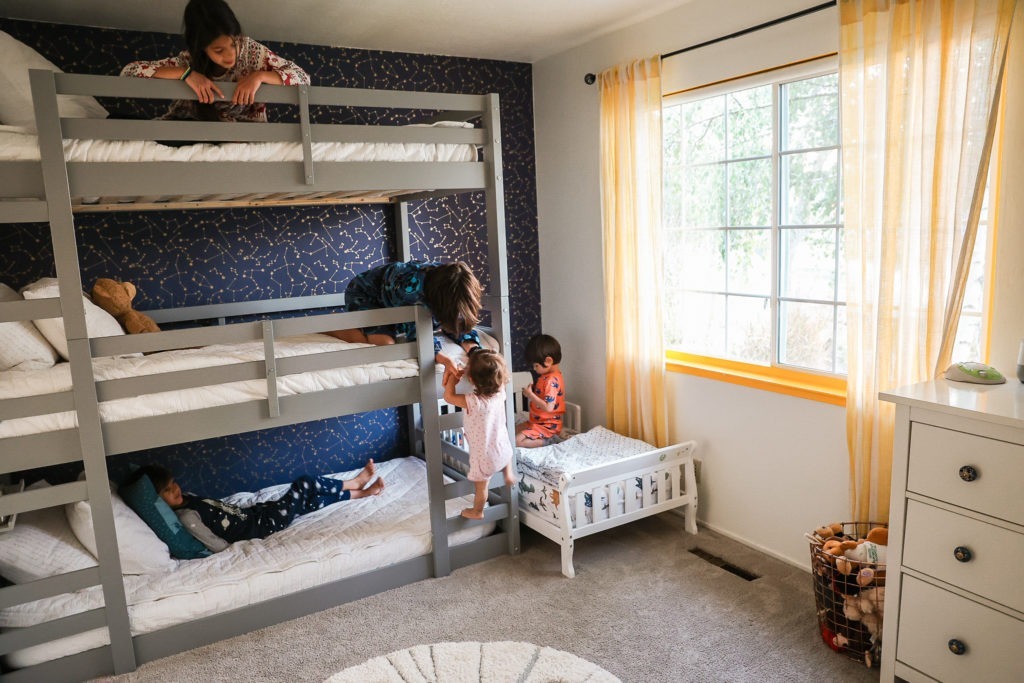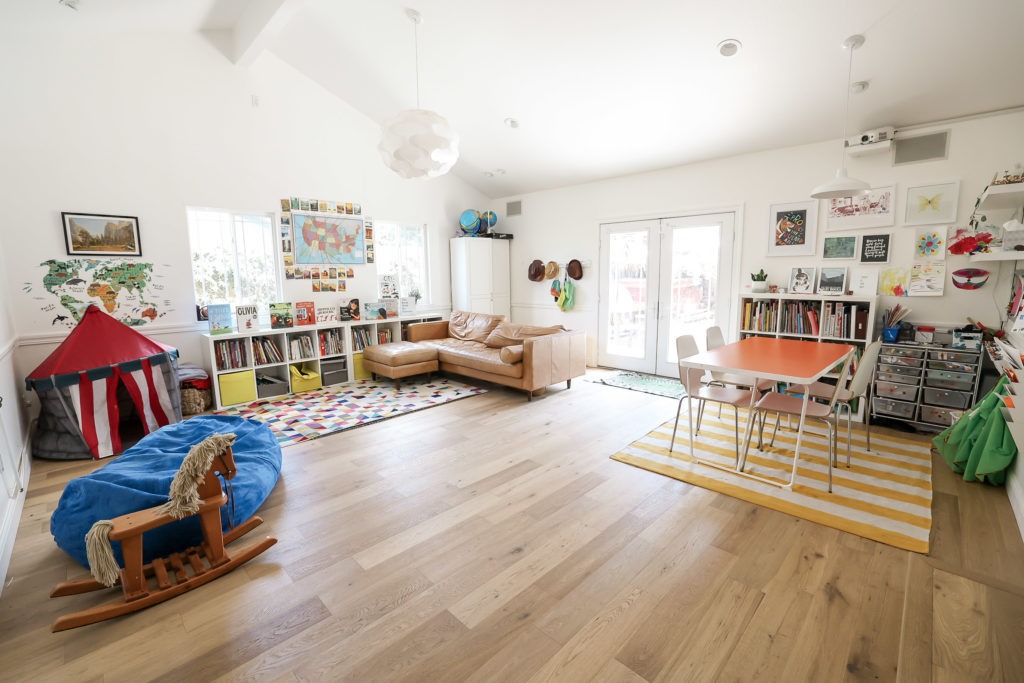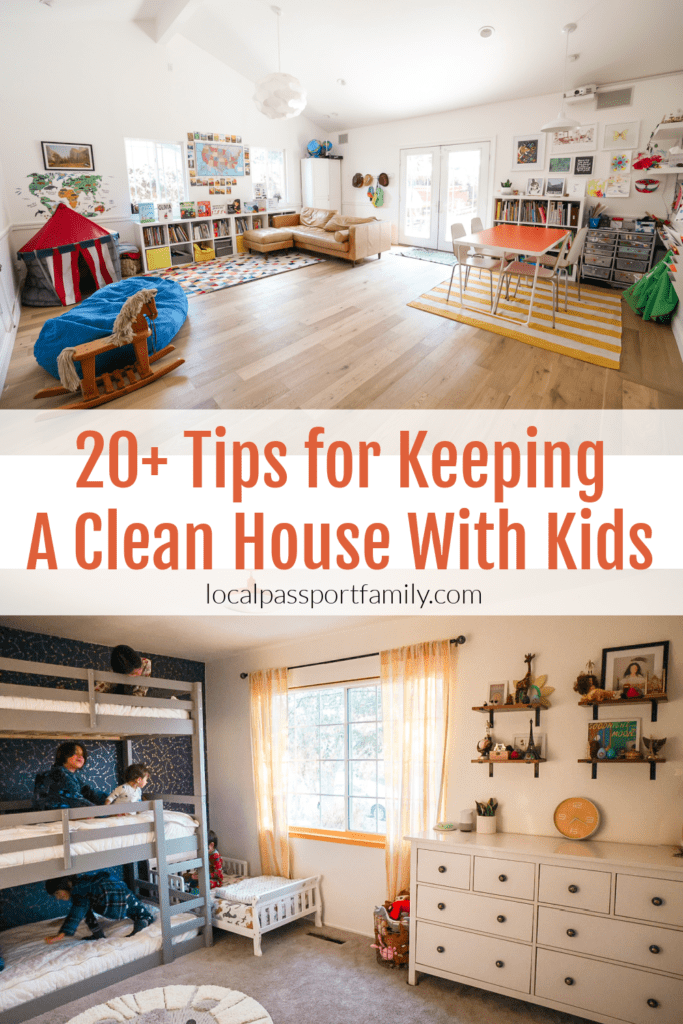After sharing our playroom organization ideas, I had tons of people ask about keeping an organized and clean house with kids. I’m 100% not an outstanding homemaker; our home is far from perfect. But I do appreciate a tidy home and have a difficult time living in a chaotic space, so I prioritize systems that allow us to reduce clutter. It definitely takes a bit more forethought to keep a clean home with a large family, but it’s worth it!
Here are 20+ tips that have been helpful to us in keeping a clean and tidy home with lots of little ones.

1. Declutter
One of the biggest parts of keeping a clean house with kids is reducing the overall amount of stuff in a space. There’s almost nothing I hate more than feeling overwhelmed by stuff, so we regularly go through and clear stuff out. I have no qualms with donating things that don’t get used often so that someone else can get joy from them. I feel zero guilt with recycling art projects and drawings after they’ve hung on the wall for a week so we can enjoy something new.
This is true both on a daily level as well as on a larger scale. This means that routinely, I get in the habit of wondering whether something is useful to our home. If it’s not, it goes in donation bin or trash. If it is, I make sure it has a clear home (see below).
This is also true when anything new comes into our home. When I know I’m giving my kids a new board game or two at Christmastime, I make sure to go through all the ones we have before the big day and donate at least one (if not 5-6). If a can opener isn’t working properly, I dispose of it before purchasing a new one. We try hard to not bring more into our house than is going out.
2. Schedule Cleaning
I hate the feeling of constantly caring for our home. I don’t want to feel like my entire life is taken over by housekeeping! So it’s helpful to me to schedule specific times for cleaning instead of constantly wondering how to keep your house clean.
Some of these times are more frequent than others. For instance, the kitchen – one of our most heavily used spaces – gets a quick clean every single night. After dinner, the whole family works together to put away all the food, wipe down the table and counters, do all the dishes, and vacuum all the floors. (This is my beloved vacuum that works super well and is lightweight enough that my kids can easily use it.) There are few things I hate more than waking up to a dirty kitchen, so this gets it back to a reasonable state every single day. I also give myself a time limit – usually by the time the kids are done getting ready for bed so we can read together – so I’m not cleaning indefinitely.
Deeper cleaning, on the other hand, tends to happen weekly. (Except for actual deep cleaning of things like wiping ceiling lights and baseboards, which, if I’m being perfectly honest, happens very rarely.) We all usually spend an hour or two on Saturday morning (or sometimes Friday night) to clean bathrooms, vacuum bedrooms, and mop floors.
3. Create Little Habits
There are certain little cleaning habits that create a ripple effect in the rest of our home. For me, a big one is making my bed (and having my kids make theirs). When there are throw pillows on the floor and sheets pulled off, I feel very little motivation to do things like vacuum and tidy. It feels off-putting because I know I’ll have to clean up the bed before even getting to those things, so I just put it all off.
On the flip side, when my bed is made, it feels easier (and more motivating) to do all the other little things. It’s the same for my kids. When at least their beds are tidy, they’re not as tempted to leave a wet towel or dirty clothes sitting out. When everyone immediately loads their breakfast dishes into the dishwasher after eating, there’s less of a temptation to leave stuff sitting out on the table or in the sink until night, when it feels overwhelming to take care of those on top of the dinner dishes.
Those little habits make such a difference in encouraging clean and tidy spaces in your home!
4. Remember Tidying Is Different Than Cleaning
We also have specific times for tidying. I find that sometimes when we start to try to clean, we end up having to tidy a bunch first. This drags things out and makes it so that we never actually get to the cleaning! It works better for us to split the tidying from the cleaning to maintain a clean house with kids.
For this, we also have more and less frequent tasks. For instance, all the kids work together to pick up the playroom every night before dinner. We’ve done this for long enough that it rarely gets to a completely disastrous state now. They know that the playroom will need to be reasonable before they can come eat, and so they self-regulate and rarely pull out 8,000 things at once. They’ve gotten in the habit of putting one thing away before pulling out another. (Except for toys – they often mix and match toys, which is great! This is more about stations – e.g., putting away art supplies before pulling out a board game.) The daily playroom tidy usually takes less than 10 minutes.
On a weekly basis, we work together to go around and rehome things that have migrated around the house – school papers, letters, stray toys and articles of clothing, etc. We often have a couple people on tidying while others clean.
5. Give Everything A Home, and Communicate It
There’s nothing like having too much stuff for a space to make me feel completely overwhelmed with cleaning it. I HATE feeling like things don’t have a home, or that they don’t fit in a space. It’s completely discouraging for me and just makes me want to give up on the whole endeavor. But when things have a clear home, it feels easy and quick to put them back and get to the actual cleaning part.
And if something doesn’t have a clear home? I try to think about when and how I use it, and where it would make sense to store it. If it doesn’t fit, then I either get rid of that or something else so it does. I can’t overstate how much easier it is to keep a tidy and clean home when there isn’t too much stuff in it.
Finally, I make sure to communicate exactly where things belong. It can be so tempting to say to my kids, “Just leave it there and I’ll put it away.” It takes so much longer to actually show them where something goes or just how to put something away (like folding towels so they fit in the cabinet). BUT once they know, they’ll be able to actually do it themselves. Which saves so much time in the future.
6. Keep A Donation Bin
Sometimes I know I need to give something away, but it sits around until I finally schedule a time to go over to the donation center. It’s been so helpful for us to have a specific donation bin (as I mentioned above). Basically ours is just a big cardboard that lives in the garage, so anytime something comes up to pass along, we chuck it in there. Once it’s full, we donate the whole thing, box and all, and replace with a fresh box. It’s easy and it keeps things from taking up space inside our home indefinitely when they’re not being used. Limiting the amount of unused stuff in your house is a great way to keep your house clean with young kids.
7. Get Kids Involved – Even Young Ones
I’m a big believer that kids gain so much from learning to contribute to a household when they’re young! We always try to help teach them how to do age-appropriate tasks during the week as well as during our weekly family house cleaning sessions.
Our family economy system has been a huge help for them to get consistent practice with certain tasks. And it’s great that they’re repeated weekly because they get faster and better at them the more they do them. This is a wonderful way to make a family plan on how to keep your house clean.
There are tons of age-appropriate chore ideas out there, but here are a few that are currently useful for us to maintain a clean house with kids:
2 Year Old Chores
- Put away clean utensils
- Put clothes in hamper
- Help switch laundry
- Match everyone’s socks
4 Year Old Chores
- Unload dishwasher
- Clean up toys
- Set dinner table
- Wipe down playroom table
7 Year Old Chores
- Take out trash
- Wipe down bathroom counters and toilets
- Vacuum hallways
- Gather towels/bathmats to wash
9 Year Old Chores
- Wash kitchen rags
- Clean bathroom
- Make dinner
- Vacuum
11 Year Old Chores
- Wash towels/bathmats
- Clean bathroom
- Make dinner
- Mop
And everyone can help with tidying and rehoming! For this to be successful, we have pretty straightforward tidying systems. In our playroom, we have one toy box each for cars, Magna Tiles, LEGOs, wooden blocks, trains, and a few little toys and musical instruments. That’s it. There’s no color coded system for LEGO. There’s no rainbow book shelving. I care much more about a system that will allow us to maintain it than some aspirational, Pinterest-perfect system. Keeping the system simple, helps us to keep a clean house with a big family.

8. Incentivize to Maintain a Clean House With Kids
We never bribe our kids to clean or pay them for specific chores. But we do incentivize their overall participation and good attitude. We phrase it as working all together for the benefit of the family, and then everyone gets family privileges. These family privileges can be simple things – like getting to manage family economy money, getting to watch a family movie together on Friday nights once everything is clean and tidy, or going out on a Saturday adventure once we’ve worked together to clean the house.
We try to communicate that the reward for all helping out in the family is getting to do fun things as a family. The entire family benefits from chipping in, and the entire family gets to live in a clean home.
We also like to use little incentives while we’re cleaning – we love turning on music, chatting, and making cleaning fun if we can. Chores don’t have to feel like a chore! And when everyone works together, cleaning and tidying the house goes much quicker.
9. Minimize Clothes & Streamline Laundry
Clothes are sort of like bunnies – they disappear when you need them and they multiply when you don’t. One of the best ways we’ve found to keep our kids rooms/drawers in check is to make sure they have the right number of clothes – not too few or too many. For each season, we like to have about 8-9 sets of clothing for each child. This is plenty that they can get through the week, with a couple spares in case of spills or other accidents. It’s also not so many that stuff sits around taking up precious real estate at the backs of the drawers.
This also allows us to do laundry just once per week, without needing to do extra loads at will. There’s almost nothing that requires us to really do emergency clothing loads, and I absolutely love it! Of course, some people prefer instead to do a load each day – that’s totally fine. (I personally don’t – it wastes more water and energy and requires me to think about laundry every day, instead of just one day a week). Either way, just choose a system and stick to it.
Since we live in a very temperate climate, a lot of our clothes cross over seasons – for instance, my kids use basically the same tops in the winter that they do in the summer, just with a jacket on top. If you live in a more extreme climate, consider swapping out clothes seasonally and storing them somewhere they don’t need to be constantly organized.
We also like to fold in the Marie Kondo method so that everything fits neatly and so drawers aren’t overflowing.
10. Have the RIGHT Items
I’m generally not a huge fan of purchasing a bunch of stuff in order to organize all the other stuff. I’d much rather just minimize the original stuff! Still, I’ve found that having a few items that work well and are easy to maintain makes a world of difference.
For instance, we spent years trying to figure out a good system for not having the kids room constantly look like a mess. With multiple kids sharing a room, a bunk bed was a must, but it’s almost impossible for even an adult to make a bunk bed nicely, much less a child. It’s just so hard to tuck everything neatly! We tried everything – tucking, folding blankets on top, just a thin blanket. Somehow, it always still looked like a mess.
I finally broke down and decided to try Beddy’s zip up bedding. And what do you know – their beds immediately looked tidy – AND THEY COULD MAINTAIN IT ON THEIR OWN. Every morning, my kids are able to make their beds nicely without me going in and retucking everything. That’s worth its weight in gold to me and my sanity.
(If you’d like to try Beddy’s, you can use the code PASSPORT to get 20% off your order.)
Similarly, our kitchen accessories drawer was always a mess until I finally got some taller plastic dividers to have all the little tools stand upright. Suddenly, my kids could actually put them back properly instead of just shoving them all in the giant drawer, and I could easily find what I needed when they were all standing up. Same with the charging station for my kids’ school Chromebooks and Kindles – nothing was stopping the stacking mess until we had the right tool to make it doable on a regular basis.
11. Think About The Next Step
I’m always reminding my kids to “think what comes next.” For instance, if I ask someone to go get the laundry out of the dryer, the next step would be to start folding their stuff. If I ask them to put the leftover dinner food in a container, instead of leaving the empty baking dish on the counter, they could wash it or put it in the dishwasher.
It’s super easy for kids to get really task focused and feel like they’re “done” when they do exactly what is asked of them. But it’s a great school and life skill to think of what comes next and what the true objective is (the end goal isn’t to get the clean laundry in the basket). They need reminders, but get better with practice (and I get to remind them less)!
12. Divide And Conquer
Along the lines of getting others involved, figure out if there are certain things that some people love or hate or are good/bad at completing. For instance, I’m efficient and thorough at cleaning counters. Dan is not. So I do the counters every single night. But he does the dishes every single night! He’s way better at loading the dishwasher and hand washing delicates than I am. It’s a great balance. When we divide and conquer all the tasks, it helps us to keep our clean house with kids an achievable goal.
Of course, sometimes things just take practice, especially with kids. That’s part of why we like keeping the same family economy chores list for about 6 months or so – it’s much more efficient for us than changing tasks every single week.
13. Keep Systems Kid-Accessible
A big part of getting kids involved in maintaining a clean home is having systems in place that they can participate in. If you have all super high-end marble counters and ultra high-end floors that require special babysitting, you may not want kids to be involved with cleaning them.
That’s not to say you can never have anything nice – you definitely can! In fact, we have marble counters in our bathrooms – but they’re very well sealed and we have easily accessible marble cleaner and rags that the kids can use. We also know that they won’t be absolutely perfect. We have a scratch here and there and some patina and it’s FINE. I’d much rather have my kids involved and living in a house than the house living for them.
We also have all our dishes stored in the cupboard directly across from the dishwasher, exactly at little kid height. This means that the little kids can easily unload the dishwasher without tons of fear of breaking dishes or having to carry heavy things a long way. (We also have mostly Ikea dinnerware and basic large and small canning jars for cups, so we’re never heartbroken if something does kick the bucket.)
This also includes bedrooms – we have drawers that are easily accessible, and installed shorter hanger rods for younger kiddos to reach. We also have a hamper in every single room so it’s easy to throw dirty clothes in there.
14. Create Hanging Systems
One thing I’ve noticed is that clutter attracts clutter. And when you have a big family, clutter can collect quickly. Before we had these hanging fruit baskets, we kept bowls of fruit on our countertops. And mail, school papers, and other junk would constantly accumulate near them! But getting some stuff off the counter has helped get other stuff off the counters, too.
15. Write It Down
Especially when it comes to multi-step tasks, I find it really helpful to write down exactly what needs to be done. This might look like printing and laminating a recipe card or a bathroom cleaning checklist (both of which we’ve done). The task lists can grow quickly when keeping a clean house so by keeping a checklist, it’s easy for anyone doing it to know exactly what not to miss.
16. Have A Command Center
Hear me out here. I know so many people tell you to not put stuff in piles, because then those piles expand. And that’s often true. But when living in a family, sometimes those things that need to be taken care of just really do need to be taken care of, and you can’t do it right that second because you have to drive to baseball practice or change diaper or give someone a snack RIGHT NOW. Whew.
So instead of having 8 thousand little piles all over the house, I like to have one central spot where I put things that need to be taken care of. (For us, it’s the big computer desk in the playroom.) Returns I need to mail back. A school form that needs to be filled out. A thank you note to send. The trick is to check this spot regularly, and to actually do all the little things instead of letting them just sit for forever. The bonus is I don’t rack my brain wondering where I put that bill because it most likely ended up in this spot!
17. Work Together
I’ve mentioned this throughout, but cleaning and tidying a home with kids tends to work much better for us when we’re all working together. My kids resist doing something unsavory if they’re the only ones working. But when we all pitch in together, everyone is less likely to slack. It’s motivating to work as a team to get something done together!
18. Practice
I’ve mentioned it a number of times throughout, but a lot of these things just take practice! And that’s okay. Just because your 6 year old doesn’t unload the entire dishwasher on their own the first time doesn’t mean they’re not capable, or that it will always take 20 minutes of cajoling. Kids are great at learning and adapting, and improve quickly when given the chance. Give it time! Taking the time to practice can even help toddlers pitch in to keeping a clean home.
19. Hire Help If You Can
Of course, this is an enormous privilege, but we occasionally (usually every couple months) hire cleaners to come in and deep clean our home. It’s one place we’ve chosen to allocate our money instead of spending hours with the deep cleaning tasks. We feel grateful to have the resources to choose that, to support a local business, and to reallocate our time.
Of course, this isn’t always feasible. But even if you aren’t able to do that, consider if there’s something you can exchange for even occasional cleaning services. Are you able to cook or babysit for someone in exchange for cleaning? Or could you tutor their child? If this is an area you really struggle, it might be worth it.
20. Get Outside to Help Keep a Clean House With Kids
For all our efforts, the best way to keep our home clean and tidy with kids is to not be in it. Most kids thrive outside (I know mine do), and we all have more fun out on adventures. I’m a better mom we all get out for a bit than when we’re all inside all day.
That’s absolutely not true for everyone. Some people love spending extended time at home, and that’s 100% okay! But if you can manage, I truly believe everyone benefits from some fresh air and movement. Whether you go on a walk, visit a museum, or just have a picnic in your front yard, getting outside works wonders. And the added benefit is that no one can create messes in your home if no one is there.
21. Know It Won’t Be Perfect
My last tip to keeping a clean house with kids it to know it won’t be perfect. Honestly, I never want to live in a house with kids that is always sparkling clean and perfectly tidy. Because that means we’re not actually living in it! I want our house to serve us, not the other way around. It’s intended to be a place where we can connect and have fun as a family. Keeping it clean and tidy is supposed to facilitate that – not take away from it.
There are some things that almost never get cleaned. And that’s okay. We basically never pull beds away from the wall to vacuum. We rarely dust bookshelves. It’s fine. It doesn’t impact our day-to-day life and I’m fine with knowing that our house is clean and tidy enough for us to relax and enjoy our time together.
IF YOU LIKED THIS POST ABOUT TIPS TO KEEPING A CLEAN HOUSE WITH KIDS, YOU MIGHT LIKE THESE POSTS TOO:
- Our Kids Playroom Organization Ideas
- Family Economy Chore Chart System
- Our Wednesday After School Family Outings
DON’T NEED TIPS TO KEEPING A CLEAN HOUSE WITH KIDS QUITE YET? PIN THIS POST FOR LATER!












If you don’t clean your house, you will be living in a germ-friendly and dirty house.
This can lead to you getting depressed, it can give you healthy problems, so by not cleaning you are practically endangering your life, and health.
Thanks for sharing these tips with us, I really like it, and it’s very helpful for me, Thanks for sharing this post with us, and keep sharing this post with us.
[…] decluttering at the end of my list but this is not how to start. While I think this is laughable, this article had some good tips to go along with that one. I even did a full review of the queen of […]
One aspect I appreciate about the article is its realistic approach to cleanliness. It acknowledges that with kids, maintaining a perfectly clean house all the time may not be feasible or necessary. Instead, the focus is on finding a balance and establishing realistic expectations. The article provides practical suggestions, such as involving children in age-appropriate cleaning tasks and setting up organizational systems that work for the whole family. Great stuff!
[…] clean home is the first step in creating a healthy environment for children. Regular cleaning not only keeps your living space aesthetically pleasing but also helps maintain a hygienic […]